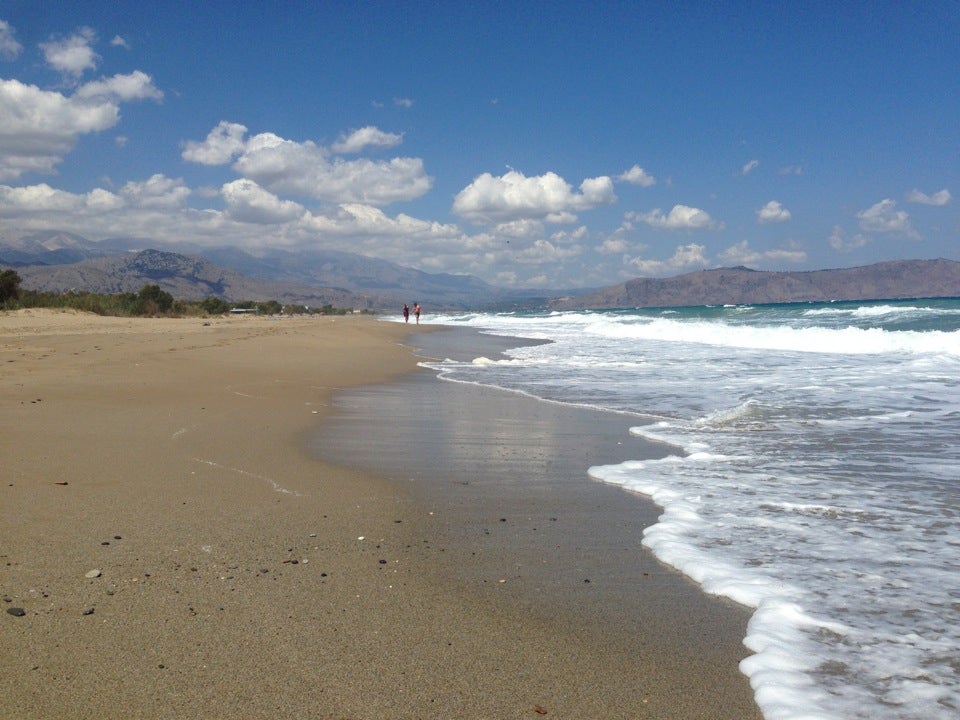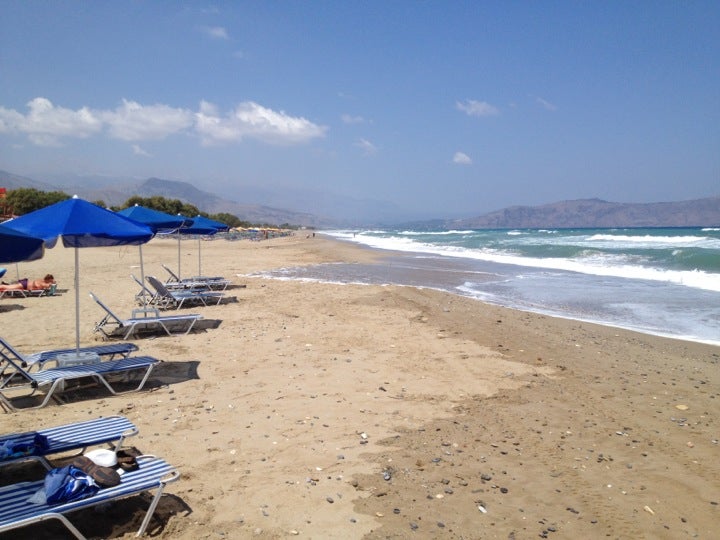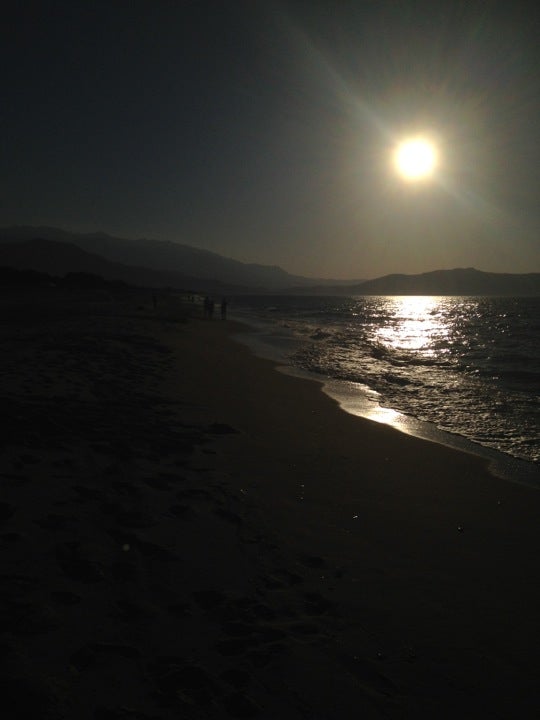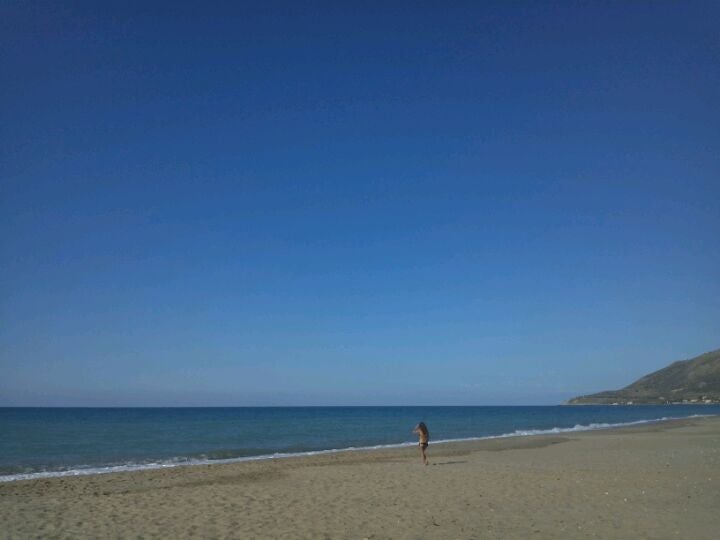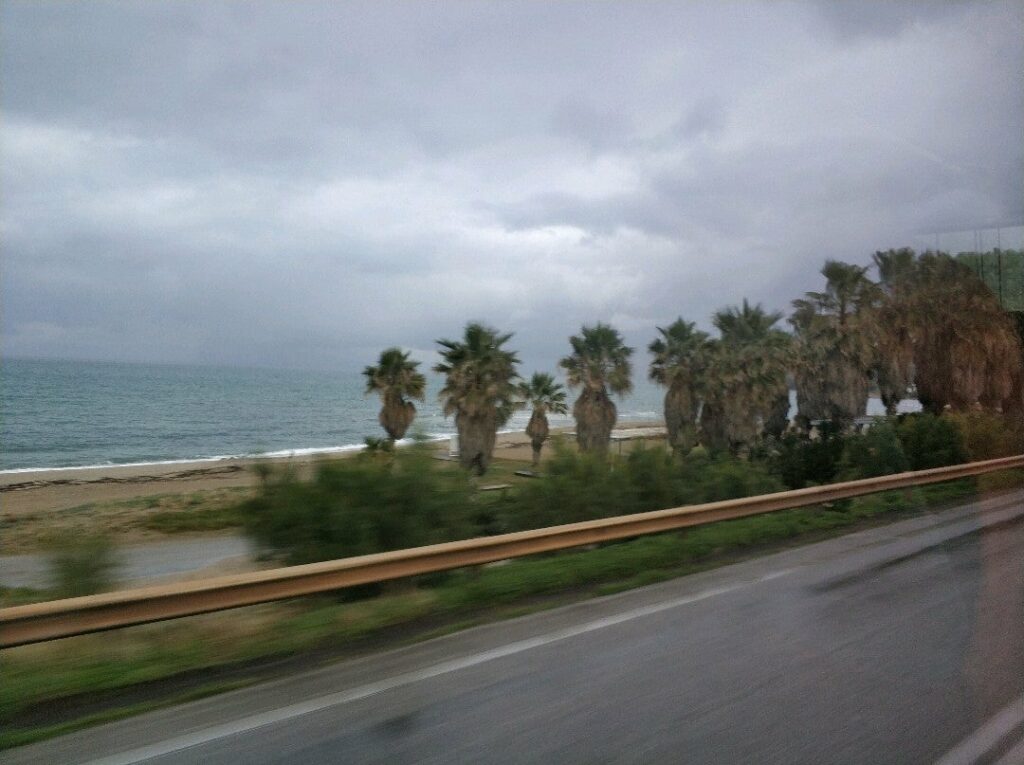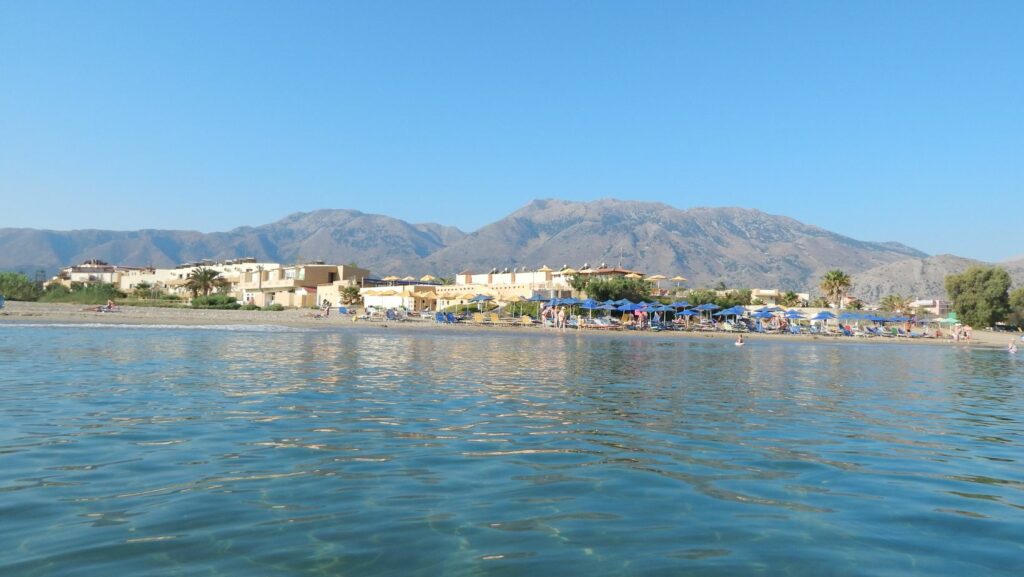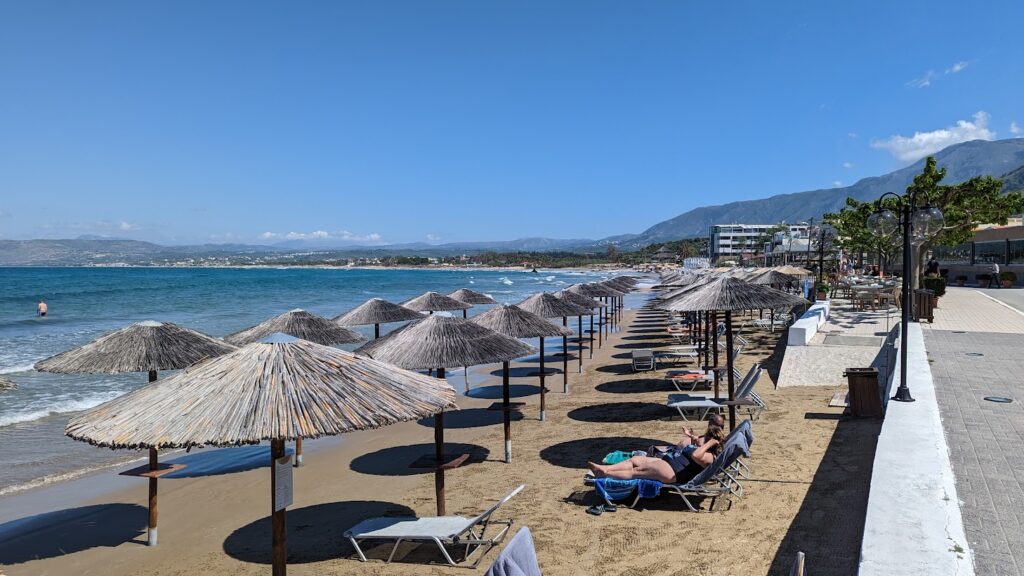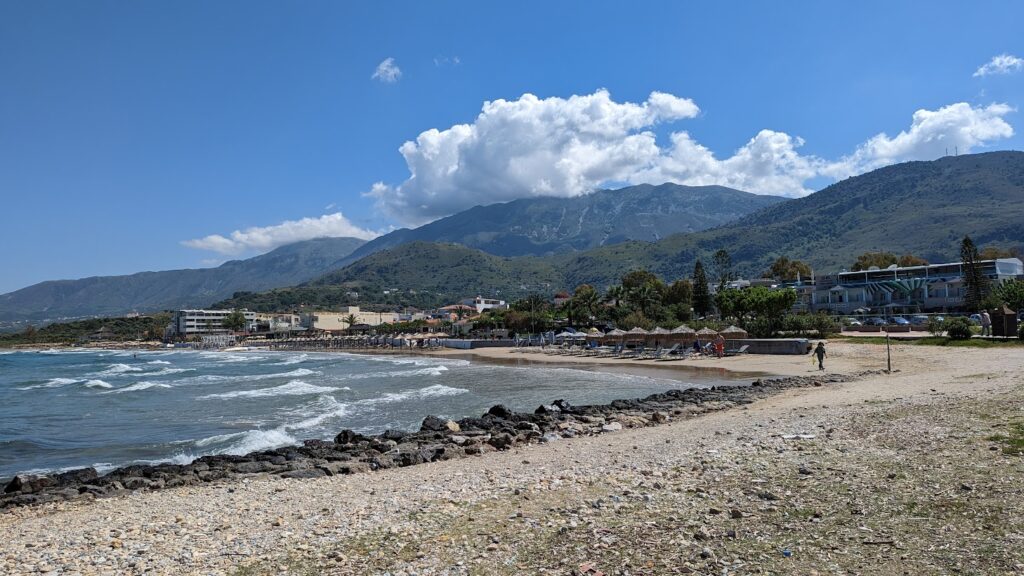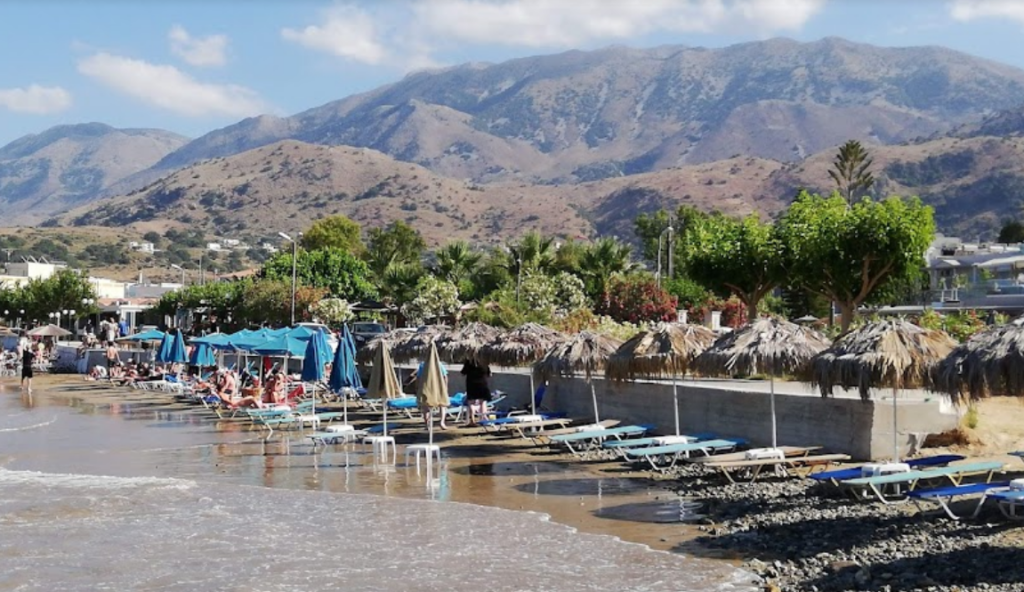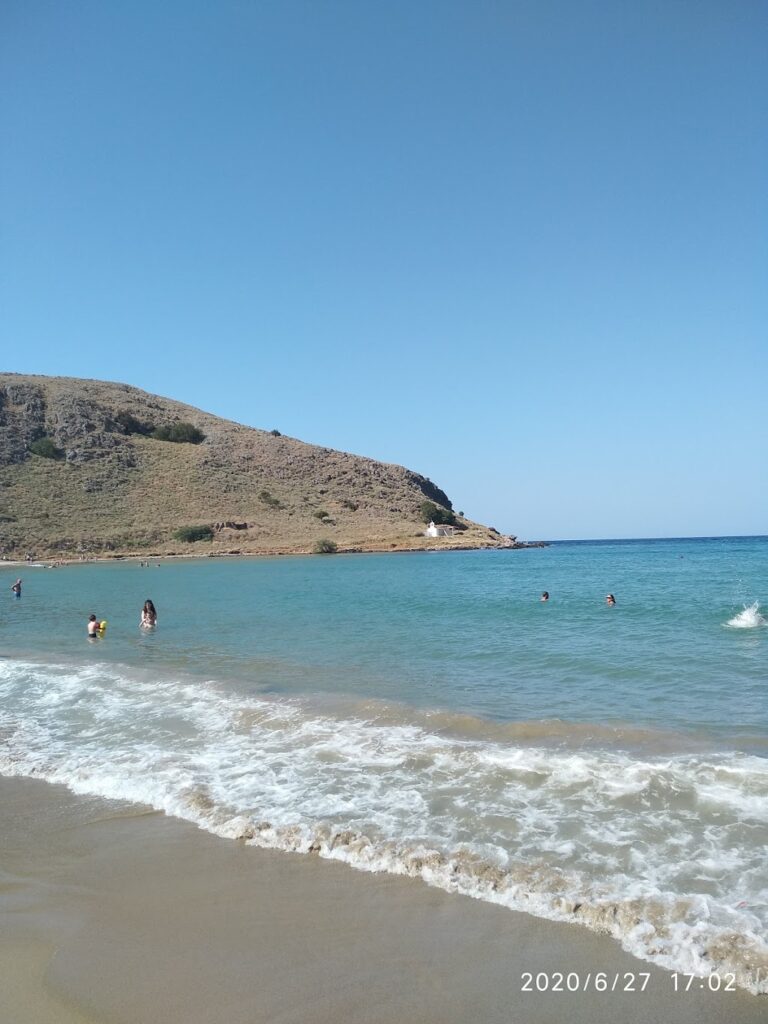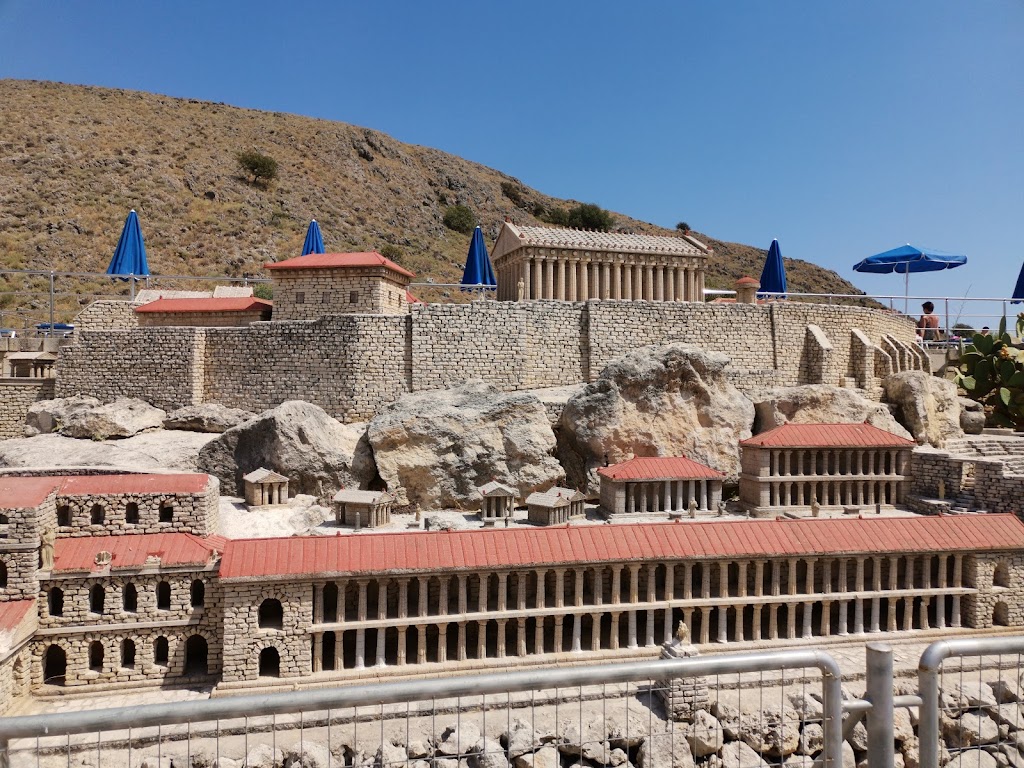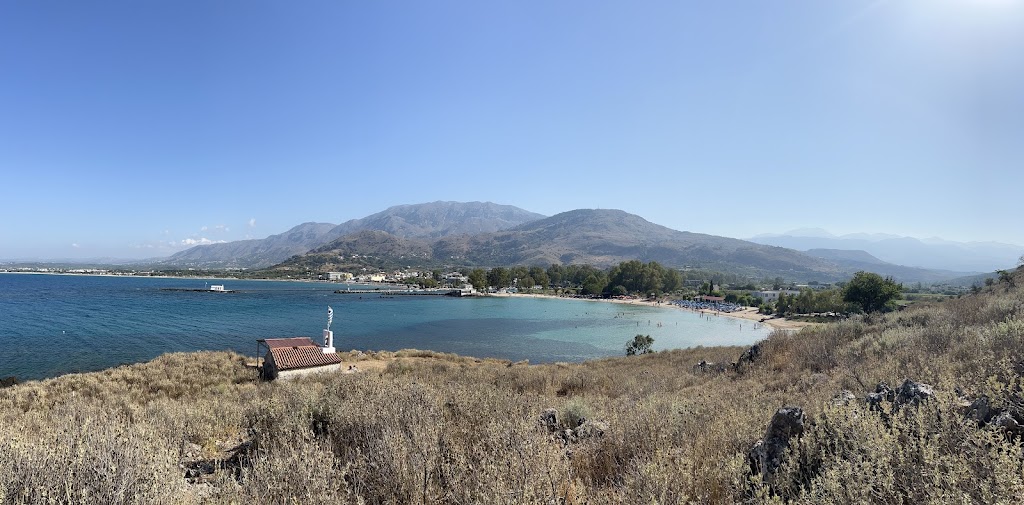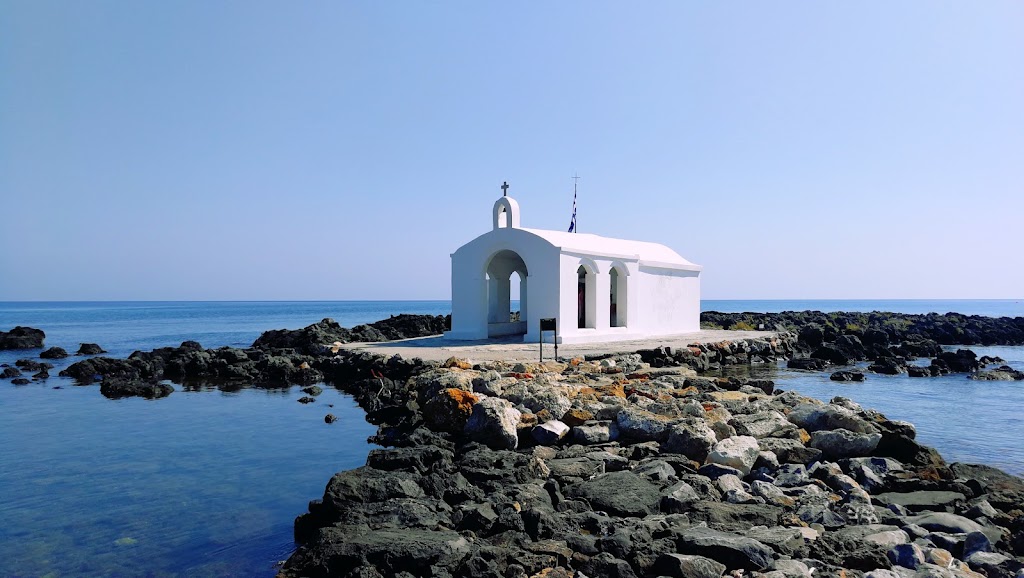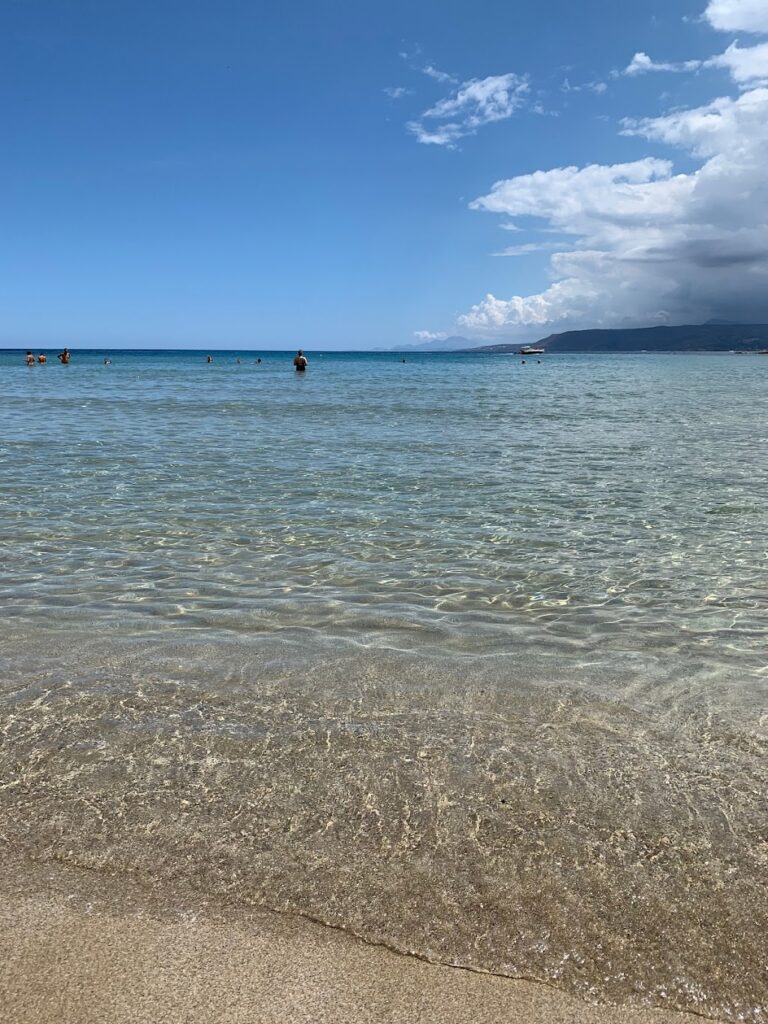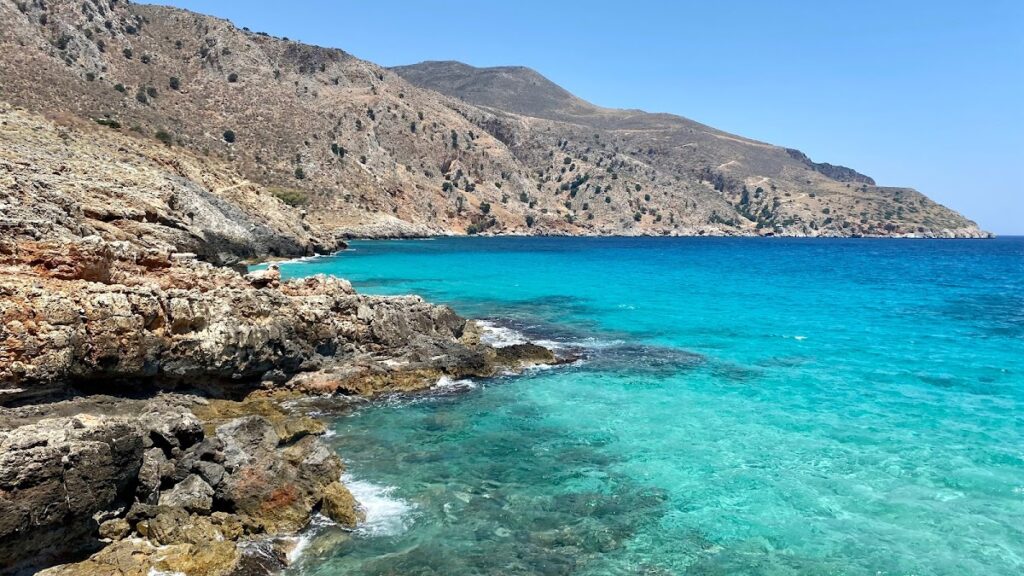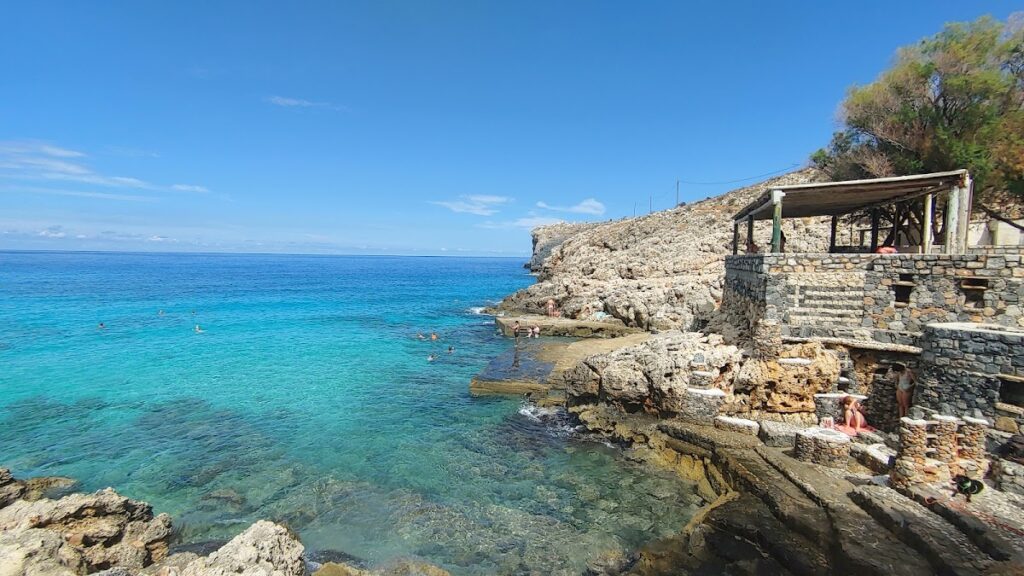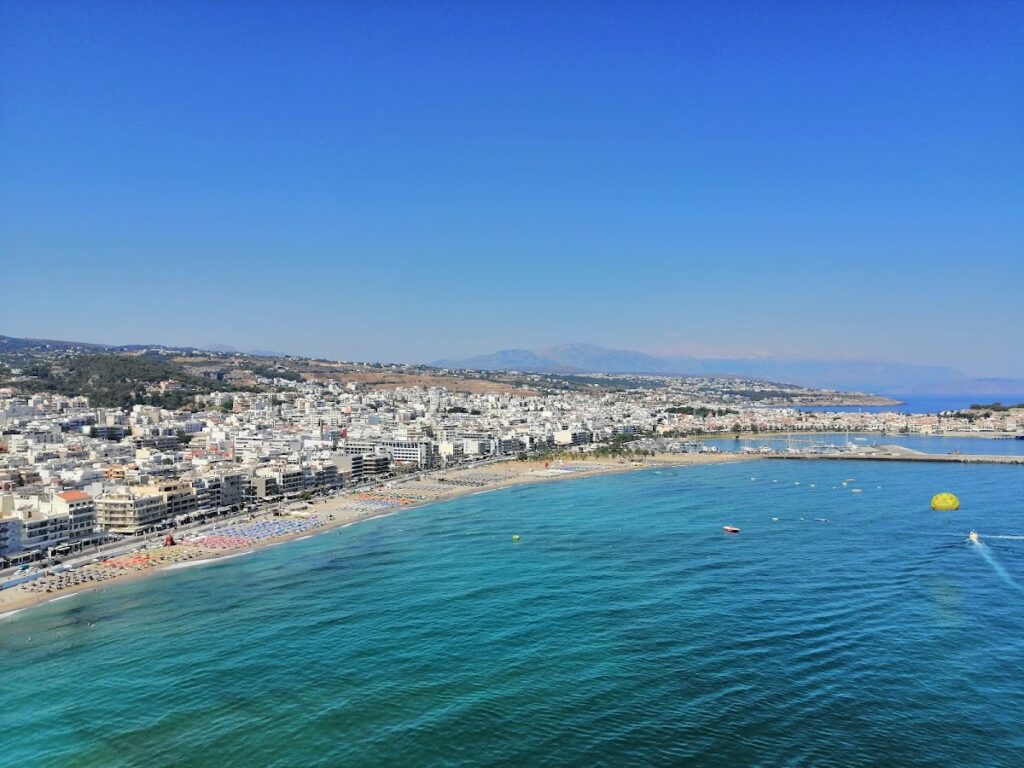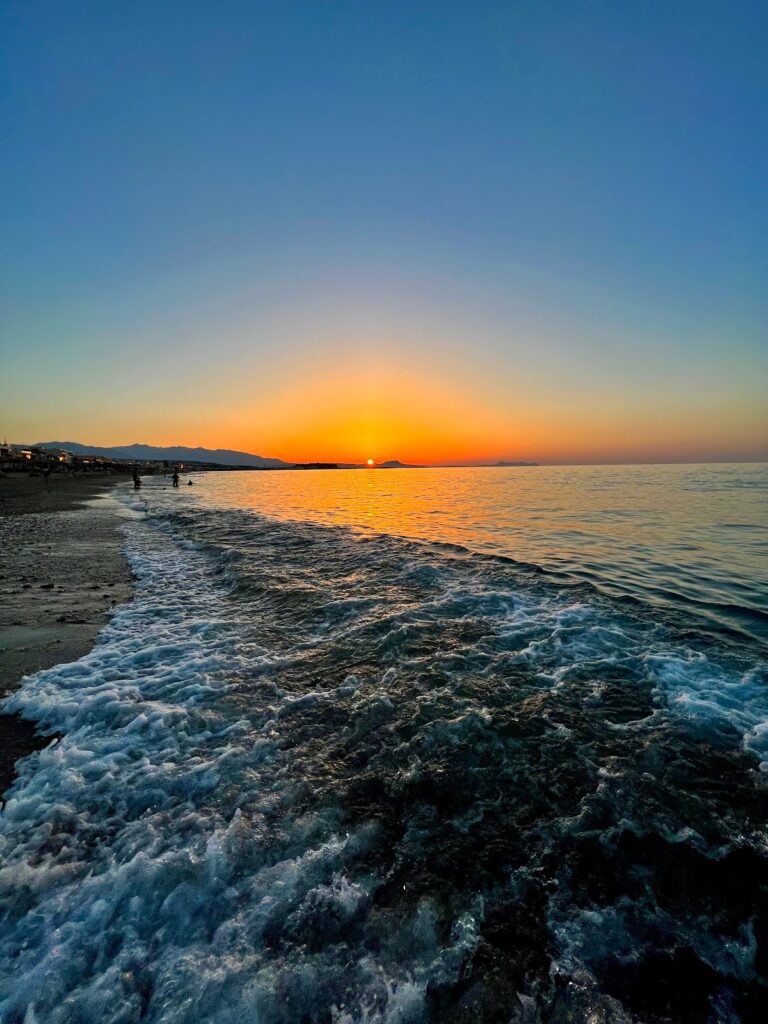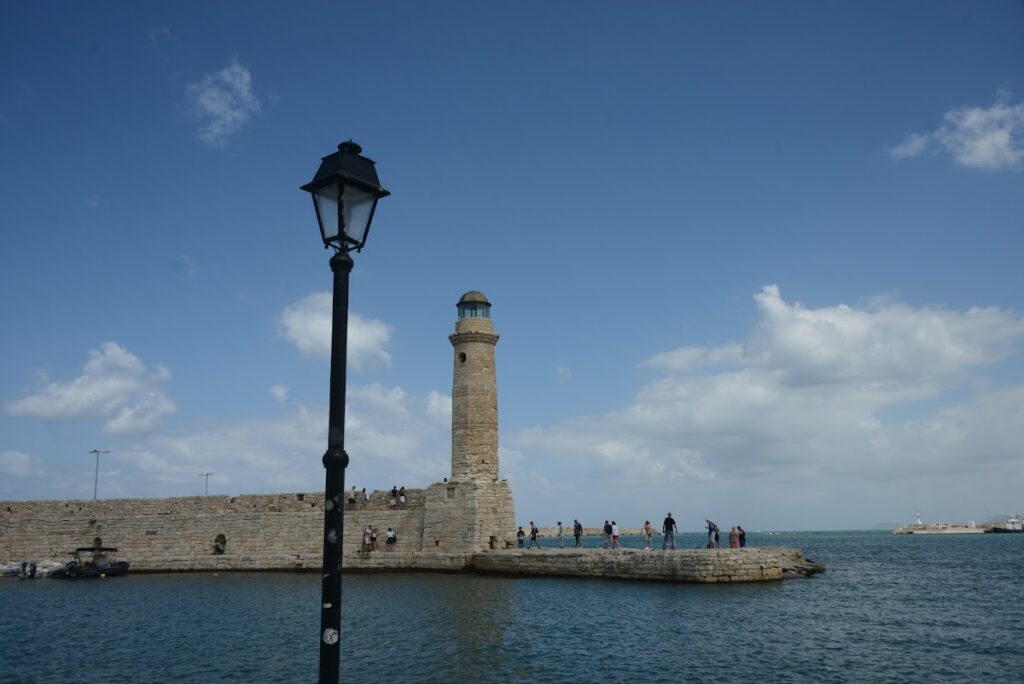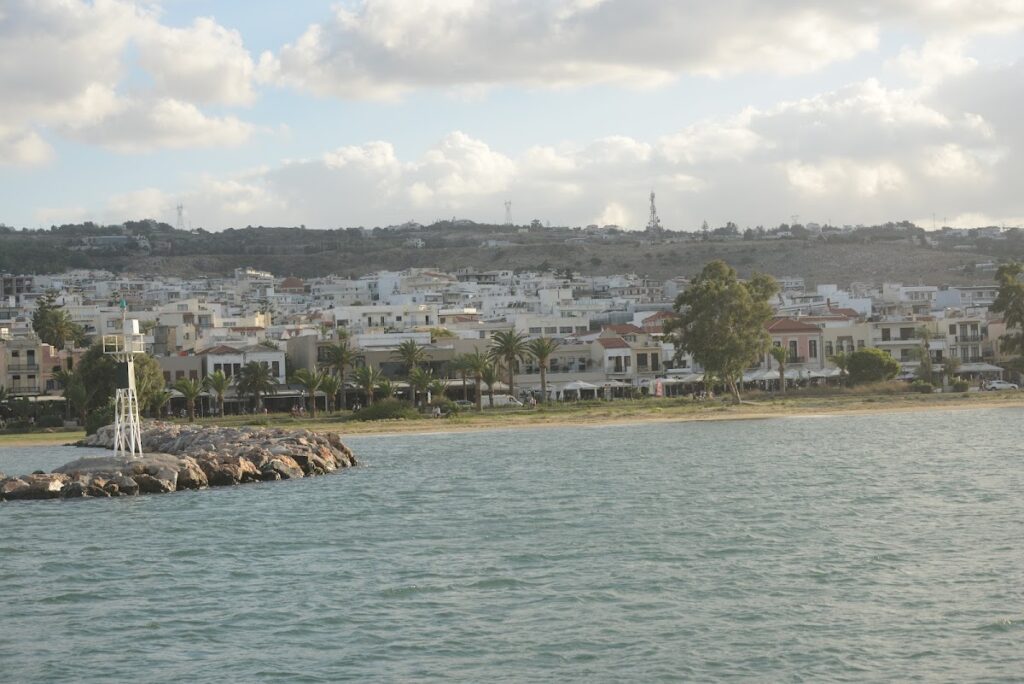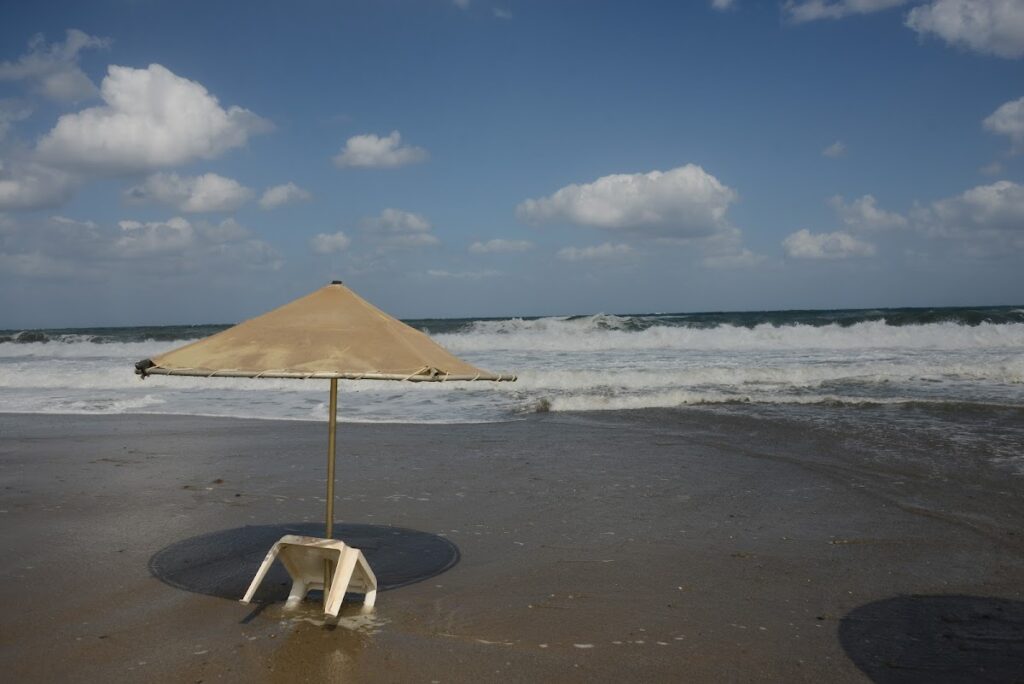Beaches near Pyrgos, in Rethymno region
Here is list of closest beaches to Pyrgos
- 220 m
- Episkopi beach
- Rocks in places, Sand
- Shallow
- Blue
The Episkopi beach, nestled 45km east of Chania and 14km west of Rethymnon, is a charming locale situated in a fertile valley with sprawling lowlands. It borrowed its name from the nearby village, Episkopi, which lies 2km south. Although the place is not widely known among Greeks, the Vardinoyannis family, one of Greece’s wealthiest business families, traces their origins to here.
The beach stretches for 3.5km and is flanked by the Mouselas river on the west and the river flowing through the Petres gorge and beaches on the west. Characteristic of most North Crete beaches, Episkopi is sandy, shallow, and typically wavy. It is well-equipped with numerous hotels, eateries, taverns, bars, and all necessary amenities. The western section of the beach offers lifeguard services, showers, changing rooms, umbrellas, snack bars, water sports, and more. However, due to its considerable length, one can also find quieter spots, especially towards the eastern end near the Petres bridge.
Rethymno and Chania are connected by a main road running parallel to the beach, making access easy either by car or bus. Regular bus services operate from Chania and Rethymno cities. Accommodation options are available in either the local region or in the village of Episkopi. Nearby attractions include the village of Argiroupolis, known for its springs and lush greenery, and Lake Kournas. Episkopi, translating to Diocese in Greek, was indeed the area’s Diocese during the Byzantine Period. However, the ancient Episcopal church of St. Nicholas is now in ruins.
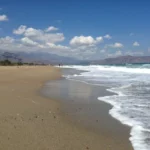
- 2.2 km
- Petres beach
- Rocks in places, Sand
- Shallow
- Blue
Situated at the eastern edge of the expansive Episkopi beachfront, Petres beach, or Stones beach, is a 46km journey east from Chania and 13km west from Rethymnon. The beach owes its name to the majestic Petres Gorge that concludes at this point. The area is dotted with facilities such as accommodations, eateries, and even a diving school. The Vythos cove, positioned north of the other areas, offers umbrellas and a less sandy terrain. The rocky underwater landscape makes it a hotspot for fishing and snorkelling. However, the frequent northern winds can cause the sea to become wavy.

- 3.7 km
- Kavros beach at Kournas
- Sand
- Shallow
- Blue
Located between Georgioupoli and Pyrgos, Kavros refers to the expansive beach situated just 4 km east of Georgioupoli, near the hotel bearing the same name. Though the area has experienced substantial tourist development, it’s somewhat less commercialized compared to the adjacent Georgioupolis. Kavros beach is a sandy stretch with transparent, shallow waters; however, its openness to the wind often results in notable wave activity. The beach provides several facilities for visitors, including an array of restaurants, cafes, and bars, making it a perfect spot for an all-day excursion. For those seeking tranquillity, parts of the beach remain unorganized, offering a more serene experience.
The place at its greatest part is developed and only a very small part of it has been left untouched. Between the remaining virgin parts of the beach, there is an extensive and very important ecosystem of dunes. The dunes of Kavros, like all dunes, host a significant and very fragile ecosystem that is home to its own plants. The most important role of the dunes in Crete is that they protect the inner lands from erosion. In the area, in winter we meet small ponds and the landscape is quite different from the summer.
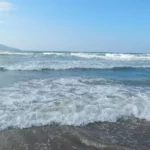
- 6.3 km
- Kamari beach
- Rocks in places, Sand
- Normal
- Blue
Kamari Beach is situated roughly 7km west of Rethymnon, close to Gerani village, at the entrance of Vederi Gorge. The coastal highway linking Chania and Rethymnon runs adjacent to the beach and over the Gerani bridge.
The beach is relatively compact, featuring pebbles and rocks in certain areas, making it a favourite among snorkelers. Despite being exposed to frequent northerly winds, it offers some amenities such as a few umbrellas, taverns, and rooms. Additionally, a quaint harbour and the charming Panagia Kamariani church can be found nearby.
A short distance south of the beach, one can find the sealed entrance to the Gerani cave, a significant archaeological site in central Crete, discovered unexpectedly during the construction of the main road. Moreover, visitors can explore the scenic narrow streets of Gerani village and visit the St George church along with several smaller churches.

- 7.0 km
- Georgioupolis beaches
- Sand
- Shallow
- Blue
Georgioupolis, a small coastal town located 38km east of Chania and 21km west of Rethymnon, is a seaside resort nestled in a verdant valley crisscrossed by rivers and springs. Situated on the western edge of a sprawling 10km beach, the town’s beach spans 2km to the east, beginning at the Almiros river and terminating at Kavros beach, a natural continuation of the former. The beach in Georgioupolis is sandy, dotted with dunes, and has shallow waters.
The beach is well-maintained and child-friendly, with lifeguards on duty. Caution is advised during windy conditions due to sea currents. Amenities such as umbrellas, showers, and food and drink stalls are available for beachgoers. Approximately 700m east of the port, the Perastikos river bifurcates the beach, which then widens as it continues eastward. On the opposite end, west of Georgioupolis’s port and near the Almyros river’s exit, lies the picturesque Kalivaki beach.
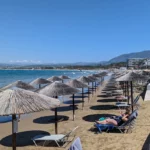
- 7.3 km
- Kalivaki beach at Georgioupolis
- Sand
- Shallow
- Blue
Located 38km east of Chania and 21km west of Rethymnon, Kalivaki is the furthest beach to the west in the bay of Georgioupolis. Nestled near the exit of the Almyros and Boutakas rivers, which maintain a steady flow of water year-round, Kalivaki is a gorgeous sandy beach. The water here is particularly cool, owing to the influence of the rivers and freshwater springs. Kalivaki is a well-appointed beach, complete with umbrellas, water sports facilities, and nearby restaurants. Its protective positioning relative to the other Georgioupolis beaches makes it an excellent choice for children, especially on windy days.
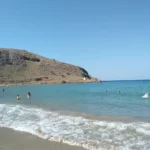
- 11.0 km
- Koumbes beach
- Sand
- Shallow
- Blue
Koumbes, situated 2km west of Rethymnon’s center, is the only beach on the city’s western side. The beach offers stunning vistas of the impressive Fortezza fortress, located several hundred meters to the east. Koumbes derives its name from the Turkish word ‘Kubbe,’ which translates to ‘dome.’ This expansive beach, adorned with sand and fine pebbles, has seen significant growth in recent years, and its development has become a top priority for the Rethymno Municipality. This growth has led to numerous improvements, including the addition of walkways and similar enhancements along the coast.
At Koumbes, visitors can avail themselves of all necessary tourist amenities, such as lifeguard services, umbrellas, showers, changing rooms, and water sports. The area also boasts numerous hotels, accommodations, restaurants, taverns, snack bars, and cafes. Access to Koumbes from the city center is convenient, either by bus or on foot. Walking takes no more than 20 minutes.

- 11.1 km
- Ombrosgialos bay
- Rocks in places
- Deep
- Deep blue, Green
Ombros Gialos (or Omprosgialos) is located 26km east of Chania, on the east coast of Drapanokefala, near Kefalas and Paleloni villages. It is a rocky beach with blue deep water. There is a small harbour with a dock, from which swimmers usually dive in the crystal waters. Next to the harbour, there is only one tavern, very famous for its fish dishes. The coast is not well organized and is quite far from well-organized accommodation choices. The sea around Ombrosgialos is ideal for snorkelers and scuba divers.
Ombrosgialos can be accessed by car through the asphalt road that starts from Paleloni. Though, another way is to come here by private boat from any nearby port, such as Georgioupolis or Kalives.
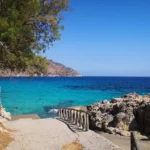
- 13.6 km
- Rethymnon beach
- Sand
- Shallow
- Blue
The golden sands and crystal clear shallow waters of Rethymno city’s beach, located a mere 500m east of the city’s core and adjacent to the Venetian port, are truly captivating. The well-organized beach is conveniently located near the city’s amenities and is the westernmost edge of Rethymno Bay’s 13km beachfront that extends eastwards to Skaleta. Despite being constantly bustling with activity, the expansive beach never feels excessively crowded. The city’s seafront road, Eleftheriou Venizelou Str., which runs parallel to the beach, provides an idyllic setting for evening strolls.
The beach offers numerous services including umbrellas, lifeguards, beach bars, showers, changing rooms, and water sports. A noteworthy fact about this beach is the presence of the loggerhead sea turtle (Carretta carretta) that nests here. Therefore, don’t be surprised to encounter roped-off areas; these are spots where eggs have been discovered and are safeguarded from swimmers. With over 400 nests annually, Rethymno Gulf ranks among Greece’s three most significant loggerhead sea turtle nesting sites.

- 15.7 km
- Pervolia beach
- Sand
- Shallow
- Blue
Three neighbouring suburbs of Rethymnon, Pervolia, Misiria, and Platanias (also known as Platanes) are situated 3-5km west of the city. Initially independent settlements, they have been subsumed into Rethymnon’s urban region due to expansion in residential development.
A lengthy sandy beach, part of Rethymnon bay’s expansive beachfront, extends in front of these suburbs. The beach begins near Rethymnon’s harbour and continues eastwards for 13km until reaching Skaleta. The beach is well-maintained and offers a wide selection of food, drink, and lodging options.
A notable feature of this beach, like the entirety of the vast beachfront, is the nesting activity of the Caretta caretta sea turtle. These turtles, protected by international law, lay their eggs in the sand. Rethymno Gulf is one of Greece’s three critical habitats for Caretta caretta, with over 400 nests documented annually.

No results available
ResetBeaches in other nearby areas
No results available
Reset